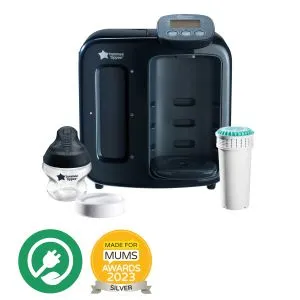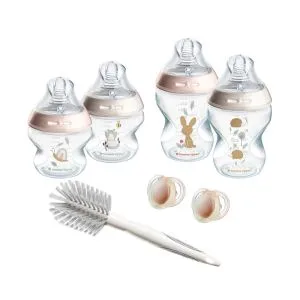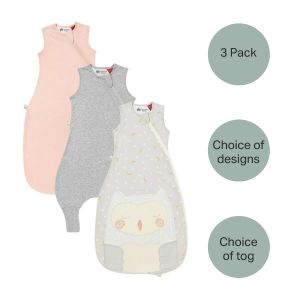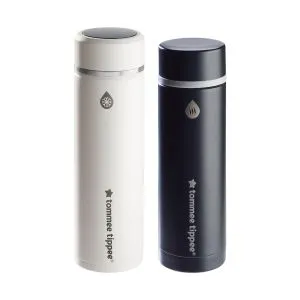
Tommee Tipps
This is your chance to introduce new flavours to the menu, and to encourage your mini-me to get the hang of chewing by doing less of the work for them and providing solid food or meals with lumpier textures.
Introducing Your Baby to Their First Solid Foods
Mastered milk? Great! Now it’s time to start mixing your baby's mealtimes up a bit.
Introducing your baby to solid or textured foods (also known as weaning or complementary feeding) usually starts when they're around six months old. You should introduce your baby to a varied diet alongside their usual breast milk or formula. In the beginning, you only need to give your baby solid or textured food once a day, at a time that suits you both.
This is your chance to introduce new flavours to the menu, and to encourage your mini-me to get the hang of chewing by doing less of the work for them and providing solid food or meals with lumpier textures. Weaning teaches your baby how to move solid food around their mouth, chew and swallow solid foods.
You may find your baby is ready for finger foods and now wants to hold the spoon and feed themselves which is both exciting and messy in equal parts. It is great to encourage independent feeding, but choking is still a risk so don’t leave them alone while eating.
Other steps to prevent choking include:
- Chopping and preparing foods as needed to make them safe
- Removing tough skins, seeds, pips and peels
- Avoiding round, smooth foods like large blueberries, whole nuts and whole grapes
- Moving through finger foods fairly gradually to allow skill development
What are the signs that my baby is ready for weaning?
When you begin weaning, you can go with your instincts, but also look out for the main signs of readiness to ensure that they're developmentally and physically ready to start having solid foods. They need to need to have an immune and digestive system that is ready to take more than milk alone and that is ready for a complex set of nutrients and compounds to break down and digest.
If they're ready, they will:
- Stay in a sitting position, holding their head steady
- Coordinate their eyes, hands and mouth so they can look at their food, pick it up and put it in their mouth
- Swallow food (rather than spitting or pushing it out)
- Make mouthing movements as they watch others eat and show an interest in food
The following behaviours can be mistaken for signs of being ready for solid food:
- Chewing their fists
- Wanting extra milk feeds
- Waking up in the night (more than usual)
Top tips for introducing textured and solid foods
- Use a highchair or chair: Make sure that babies and young children are alert and seated safely upright in a highchair whilst eating.
- Watch your own facial expression: If you frown as you present certain foods, your baby will sense your negativity and become unsure of what you're offering them.
- Don’t lose heart if they seem to ‘dislike’ a food: It may take 10 tries or more for your baby to get used to new foods, flavours and textures. There will be days when they eat more, some when they eat less, and then days when they reject everything. Don’t worry – this is perfectly normal. Stop when they shut their mouth, turn away or arch their back. It can take a while for them to get used to a new flavour, so don’t force it.
- Try and include your baby when the rest of the family are eating: This means that mealtimes become a social occasion and because babies learn by watching, they can learn by observing and follow your lead.
- Follow their lead: Most babies are ready for weaning from six months onwards, but be guided by your baby before you start introducing textured and solid (but soft) baby food. If your baby was born prematurely, ask your health visitor or GP for advice on when to start weaning.
- Embrace the mess: When they first start baby-led weaning, your baby might throw most (or all) of the food on the floor, taste the food only to then spit it out, and even smear the food in their hair. These are all totally normal, so don’t stress and let your baby have fun with food! It’s messy, but will help your little one learn to feed themselves as well as be more likely to taste a new food you’ve provided.
- Be mindful of teething: If your little one is pushing away the bite-sized meal in front of him, it may be because his gums are hurting. Try offering a cool puree instead.
- Breast milk and formula are still important: But give your baby solids before them to encourage them to accept new foods.
Baby weaning schedule
Below you can find a weaning schedule and how much food to give your baby when weaning at different ages.
Weaning from six months
- Baby shows signs of weaning 'readiness'
- Begin to introduce single tastes of fruits and vegetables
- Start with one small meal a day
- Offer purees or finger foods
- Introduce foods that can trigger allergic reactions early in the day, one at a time and in very small amounts so that you can spot any reaction
- Leave a two or three day gap between each allergen introduction, then move on to the next
- Continue to offer your baby breast milk or formula
Weaning from seven to nine months
- Gradually start to move towards three meals
- Increase the variety of foods and offer iron rich ingredients
- Offer milk responsively
Weaning from ten months to one year
- Offer three meals a day
- Offer family foods that vary in taste and texture
- Offer milk responsively
How do you move on from purees to textured food?
Moving on from purees really helps babies to enjoy a wide and varied diet, and the whole weaning process is all about the gradual transition to family foods. This includes a gradual transition through textures. Purees, to mashed foods to lumpy foods to solid foods.
- Initially, you want a nice smooth runny puree that runs off the spoon like soup for your first few tastes. Then you want to think about moving the texture up a notch to continue baby’s progress.
- Next, move onto a texture that falls off the spoon in a few small dollops.
- Finally, when baby is more than capable of swallowing non-liquid food from a spoon, you can opt for a mined or chopped texture and offer it alongside soft finger foods.
What shape and size should my baby’s first solid finger foods be?
When it comes to first finger foods, it’s generally recommended to offer little one's finger foods that are baton-shaped (around the size and shape of an adult finger), and squidge-able between your finger and thumb so that your baby can squash the food in their mouth using their tongue and the roof of their mouth of gums.
Ideally finger foods should be sturdy enough to be held, but soft enough to be flattened with a little pressure. Avoid round shapes and firm foods and cut small round fruits like grapes, cherries, berries, strawberries, and cherry tomatoes into quarters.
What foods should babies and toddlers not have?
- Salt: Babies should not eat much salt, as it's not good for their kidneys. Do not add salt to your baby's food or cooking water, and do not use stock cubes or gravy, as they're often high in salt. Remember this when you're cooking for the family if you plan to give the same food to your baby.
- Sugar: Your baby does not need sugar. By avoiding sugary snacks and drinks (including fruit juice and other fruit drinks), you'll help prevent tooth decay.
- Saturated fat: Do not give your child too many foods that are high in saturated fat, such as crisps, biscuits and cakes. Checking the nutrition labels can help you choose foods that are lower in saturated fat.
- Honey: Occasionally, honey contains bacteria that can produce toxins in a baby's intestines, leading to infant botulism, which is a very serious illness. Don’t give them honey until they're over one year old. Honey is a sugar, so avoiding it will also help prevent tooth decay.
- Whole nuts and peanuts: Whole nuts and peanuts shouldn't be given to children under five years old, as they can choke on them. You can give your baby nuts and peanuts from around six months old, as long as they're crushed, ground or a smooth nut or peanut butter. If there's a history of food allergies or other allergies in your family, talk to your doctor or health visitor before introducing nuts and peanuts.
- Some cheeses: Babies can eat pasteurised full-fat cheese from six months old. This includes hard cheeses, such as mild cheddar cheese, cottage cheese and cream cheese. However, babies and young children should not eat mould-ripened soft cheeses or cheeses made from unpasteurised milk because of the risk of listeria.
- Raw and lightly cooked eggs: Babies can have eggs from around 6 months. If the eggs are hens' eggs and they have a red lion stamped on them, or you see a red lion with the words "British Lion Quality" on the box, it's fine for your baby to have them raw (for example, in homemade mayonnaise) or lightly cooked. Eggs that don’t have the red lion mark should be cooked until both the white and yolk are solid. So should duck, goose or quail eggs. Avoid raw eggs, including uncooked cake mixture, homemade ice creams, homemade mayonnaise, or desserts that contain uncooked egg that you cannot confirm are red lion stamped.
- Rice drinks: Children under five years old shouldn’t have rice drinks as a substitute for breast milk or infant formula (or cows' milk after one year old) as they can contain too much arsenic. Do not worry if your child has already had rice drinks. There's no immediate risk to them, but it's best to switch to a different kind of milk.
- Raw jelly cubes: These can be a choking hazard for babies and young children. If you're making jelly from raw jelly cubes, make sure you always follow the manufacturers' instructions.
- Popcorn: Do not give popcorn to babies and young children.
- Boiled or sticky sweets and ice cubes: Do not give boiled, hard, gooey, sticky sweets (including cough sweets chewing gum or marshmallows) or ice cubes to babies and young children.
- Raisins and other dried fruits: Do not give whole raisins or dried fruits to babies under the age of one, and always cut them into small pieces.
- Raw shellfish: Raw or lightly cooked shellfish, such as mussels, clams, and oysters, can increase the risk of food poisoning, so it's best not to give it to babies.
- Shark, swordfish, and marlin: Do not give your baby shark, swordfish, or marlin. The amount of mercury in these fish can affect the development of a baby's nervous system.











